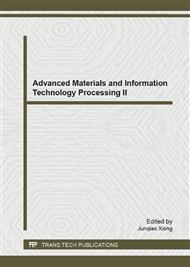[1]
Hyvärinen, A; Oja, E (2000). Independent Component Analysis: Algorithms and Applications. Neural Networks, 13(4-5), 411-430.
DOI: 10.1016/s0893-6080(00)00026-5
Google Scholar
[2]
Hyvärinen, A (1999). Fast and Robust Fixed-Point Algorithms for Independent Component Analysis. IEEE Transactions on Neural Networks, 10(3), 626-634.
DOI: 10.1109/72.761722
Google Scholar
[3]
Linh-Trung Nguyen, Adel Belouchrani, Karim Abed-Meraim, Baualem Boashash Separating More Sources then Sensors Using Time-Frequency Distributions Signal Processing and its Applications, Sixth International, 583-686 vol. 2 . (2001).
DOI: 10.1109/isspa.2001.950212
Google Scholar
[4]
A. Belouchrani and M.G. Amin, Blind source separation based on time-frequency signal representations, IEEE Trans. Spch. Aud. Proc. vol. 46, pp.2888-2897, Nov. (1998).
DOI: 10.1109/78.726803
Google Scholar
[5]
Wang, Jing Hui; Zhao, Yuan Chao, Blind source separation based on wavelet and cross-wavelet, Advanced Materials Research, Guangzhou, China, 2011, 2064-(2068).
DOI: 10.4028/www.scientific.net/amr.328-330.2064
Google Scholar
[6]
Wang, JingHui; Zhao, YuanChao, Blind source separation based on power spectral density Lecture Notes in Computer Science Volume: 7003 LNAI PART 2, 2011, 602-609.
DOI: 10.1007/978-3-642-23887-1_77
Google Scholar
[7]
Zeyong Shan, AviyenteSource Separation in the Time-Frequency Domain by Maximizing an Information-Theoretic Criterion. Electro/information Technology, 2006 IEEE International Conference, 43-48, 7-10 May (2006).
DOI: 10.1109/eit.2006.252162
Google Scholar
[8]
Reju, V.G. Soo Nqee Koh, Ing Yann SoonUnderdetermined Convolutive Blind Source Separation via TimeCFrequency Masking. Audio, Speech, and Language Processing, IEEE Transactions, 101-116, (2010).
DOI: 10.1109/tasl.2009.2024380
Google Scholar
[9]
Zeyong Shan;, Swary. J, Aviyente.S. Underdetermined Source Separation in the Time-Frequency Domain. Acoustics, Speech and Signal Processing, International Conference, 945-948, (2007).
DOI: 10.1109/icassp.2007.366837
Google Scholar


